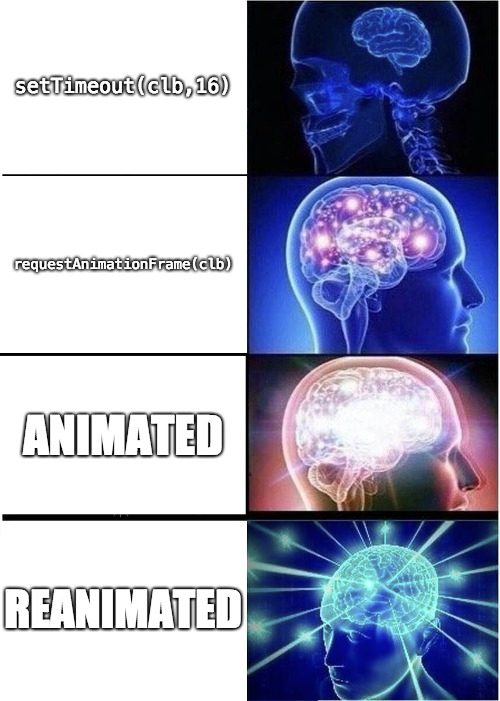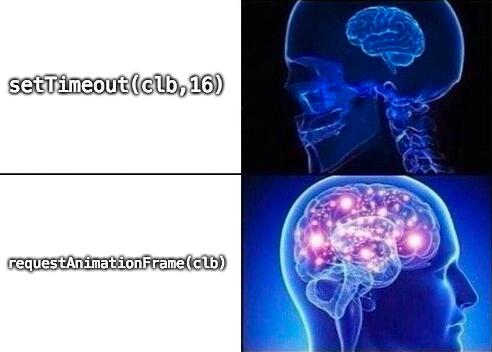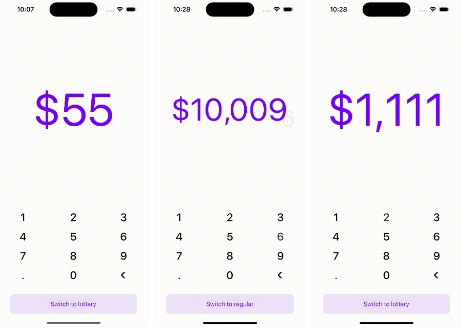react-native-reanimated
React Native's Animated library reimplemented.

It provides a more comprehensive, low level abstraction for the Animated library API to be built on top of and hence allow for much greater flexibility especially when it comes to gesture based interactions.

OMG, why would you build this? (motivation)
Animated library has several limitations that become troubling when it comes to gesture based interactions.
I started this project initially to resolve the issue of pan interaction when the object can be dragged along the screen and when released it should snap to some place on the screen.
The problem there was that even though using Animated.event we could map gesture state to the position of the box and make this whole interaction run on UI thread with useNativeDriver flag, we still had to call back into JS at the end of the gesture for us to start "snap" animation.
It is because Animated.spring({}).start() cannot be used in a "declarative" manner, that is when it gets executed it has a "side effect" of starting a process (an animation) that updates the value for some time.
Adding "side effect" nodes into the current Animated implementation turned out to be a pretty difficult task as the execution model of the Animated API is that it runs all the dependent nodes each frame for the views that needs to update.
We don't want to run "side effects" more often than necessary as it would, for example, result in the animation starting multiple times.
Another reason why I started rethinking how the internals of Animated can be redesigned was my recent work on porting "Animated Tracking" functionality to the native driver.
Apparently even so the native driver is out for quite a while it still does not support all the things non-native Animated lib can do.
Obviously, it is far more difficult to build three versions of each feature (JS, Android and iOS) instead of one, and the same applies for fixing bugs.
One of the goals of reanimated lib was to provide a more generic building block for the API, that would allow for building more complex features only in JS and make the native codebase as minimal as possible.
Let's take "diffClamp" node as an example, it is currently implemented in three different places in Animated core and even though it is pretty useful it actually only has one use case (collapsible scrollview header).
On a similar topic, I come across React Native's PR #18029 and even though it provides a legitimate use case I understand the maintainers being hesitant on merging it. The Animated API shouldn't block people from building things like this and the goal of reanimated API is to provide lower level access that would allow for implementing that and many more features with no necessary changes to the core of the library.
You can watch my React Europe talk where I explain the motivation.
The goals:
- More generic primitive node types leads to more code reuse for the library internals and hence makes it easier to add new features and fix bugs.
- The new set of base nodes can be used to implement Animated compatible API including things like:
- Complex nodes such as “diffClamp”.
- Interactions such as animated value tracking or animation staggering.
- Conditional evaluation & nodes with side effects (
set,startClock,stopClock). - No more “useNativeDriver” – all animations runs on the UI thread by default
Getting started
Before you get started you should definitely familiarize yourself with the original Animated API first. Refer to the API description below and to the Examples section to learn how to use this library.
Throughout this document when we refer to classes or methods prefixed with Animated we usually refer to them being imported from react-native-reanimated package instead of plain react-native.
Installation
I. First install the library from npm repository using yarn:
yarn add react-native-reanimated
II. Link native code with react-native cli:
react-native link react-native-reanimated
III. When you want to use "reanimated" in your project import it from react-native-reanimated package:
import Animated from 'react-native-reanimated';
Similarly when you need Easing import it from react-native-reanimated package instead of react-native:
import Animated, { Easing } from 'react-native-reanimated';
Reanimated vs Animated
We aim to bring this project to be fully compatible with Animated API. We believe that the set of base nodes we have selected should make this possible to be done only by writing JS code and does not require significant changes in the native codebases. Here is a list of things that hasn't yet been ported from the original version of Animated library.
All the functionality that missing elements provide in Animated can be already achieved with reanimated although a different methodology for implementing those may be required (e.g. check "Running animations" section to see how the implementation may differ).
- [ ] using value offsets
- [ ] imperative api for starting animations (
Animated.timing({}).start()and similar) - [ ] value tracking (can be achieved in different way, reanimated also allows for tracking all the animation parameters not only destination params)
- [ ] animation delays
- [ ] animation staggering
- [ ] interpolate method
Clocks
Original Animated API makes an "animation" object a first class citizen.
Animation object has many features and therefore requires quite a few JS<>Native bridge methods to be managed properly.
In "reanimated" clocks aims to replace that by providing more of a low level abstraction but also since clock nodes behave much the animated values they make the implementation much less complex.
Animated.Clock node is a special type of Animated.Value that can be updated in each frame to the timestamp of the current frame. When we take Clock node as an input the value it returns is the current frame timestamp in milliseconds. Using special methods clock nodes can be stopped started and we can also test if clock has been started.
Because Animated.Clock just extends the Animated.Value you can use it in the same places (operations) where you can pass any type of animated node.
At most once evaluation (the algorithm)
Unlike the original Animated library where each node could have been evaluated many times within a single frame reanimated restricts each node to be evaluated at most once in a frame.
This restriction is required for nodes that have side-effects to be used (e.g. set or startClock).
When node is evaluated (e.g. in case of an add node we want to get a sum of the input nodes) its value is cached. If within the next frame there are other nodes that want to use the output of that node instead of evaluating we return cached value.
This notion also helps with performance as we can try to evaluate as few nodes as expected.
The current algorithm for making decisions of which nodes to evaluate works as follows:
- Each frame we first analyze the generated events (e.g. touch stream). It is possible that events may update some animated values.
- Then we update values that corresponds to clock nodes that are "running".
- We traverse nodes tree starting from the nodes that have been updated in the current cycle and we look for final nodes that are connected to views.
- If we found nodes connected to view properties we evaluate them. This can recursively trigger evaluation for their input nodes etc.
- After everything is done we check if some "running" clocks exists. If so we enqueue a callback to be evaluated with the next frame and start over from pt 1. Otherwise we do nothing.
Blocks
Blocks are just an arrays of nodes that are being evaluated in a particular order and return the value of the last node. It can be created using block command but also when passed as an argument to other nodes the block command can be omitted and we can just pass a nodes array directly. See an example below:
cond(
eq(state, State.ACTIVE),
[
stopClock(clock),
set(transX, add(transX, diffX))
],
runTiming(clock, state, config)
)
Passing array directly is equivalent to wrapping it with the block command.
API reference
Views, props, etc
Follow the original Animated library guides to learn how values can be connected to View attributes.
Similarly with reanimated you need to use components prefixed with Animated. (remember to import Animated from reanimated package). For example:
import Animated from 'react-native-reanimated';
// use
<Animated.View/>
// instead of
<View/>
Available nodes
set
set(valueToBeUpdated, sourceNode)
When evaluated it will assign the value of sourceNode to the Animated.Value passed as a first argument. In oder word it performs an assignment operation from the sourceNode to valueToBeUpdated value node.
cond
set(conditionNode, ifNode, [elseNode])
If conditionNode evaluates to "truthy" value the node evaluates ifNode node and returns its value, otherwise it evaluates elseNode and returns its value. elseNode is optional.
block
block([node1, ...])
Takes an array of nodes and evaluates all the nodes in the order they are put in the array. Then return the value of the last node.
debug
debug(messageString, valueNode)
When the node is evaluated it prints to the console (using console.log or other means on native) a string that contains the messageString concatenated with the value of valueNode. Then returns the value of valueNode. Note that messageString should be a normal string not an animated node.
startClock
startClock(clockNode)
When evaluated it will make Clock node passed as an argument to start updating its value each frame. Then return 0.
stopClock
stopClock(clockNode)
When evaluated it will make Clock node passed as an argument to stop updating its value if it has been doing that. Then return 0.
clockRunning
clockRunning(clockNode)
For a given Clock node it returns 1 if the clock is updating each frame (it has been started) or return 0 otherwise.
event
Works the same way as with the original Animated library.
add
add(nodeOrNumber1, nodeOrNumber2, ...)
Takes two or more animated nodes or values, and when evaluated returns their sum.
sub
sub(nodeOrNumber1, nodeOrNumber2, ...)
Takes two or more animated nodes or values, and when evaluated returns the result of subtracting their values in the exact order.
multiply
multiply(nodeOrNumber1, nodeOrNumber2, ...)
Takes two or more animated nodes or values, and when evaluated returns the result of multiplying their values in the exact order.
divide
divide(nodeOrNumber1, nodeOrNumber2, ...)
Takes two or more animated nodes or values, and when evaluated returns the result of dividing their values in the exact order.
pow
pow(nodeOrNumber1, nodeOrNumber2, ...)
Takes two or more animated nodes or values, and when evaluated returns the result of dividing their values in the exact order.
modulo
sqrt
sin
sin(node)
Returns a sine of the value of the given node.
cos
cos(node)
Returns a cosine of the value of the given node.
exp
exp(node)
Returns an exponent of the value of the given node.
lessThan
lessThan(nodeOrValueA, nodeOrValueB)
Returns 1 if the value of the first node is less than the value of the second node. Otherwise returns 0.
eq
eq(nodeOrValueA, nodeOrValueB)
Returns 1 if the value of both nodes are equal. Otherwise returns 0.
greaterThan
greaterThan(nodeOrValueA, nodeOrValueB)
Returns 1 if the value of the first node is greater than the value of the second node. Otherwise returns 0.
lessOrEq
lessOrEq(nodeOrValueA, nodeOrValueB)
Returns 1 if the value of the first node is less or equal to the value of the second node. Otherwise returns 0.
greaterOrEq
greaterOrEq(nodeOrValueA, nodeOrValueB)
Returns 1 if the value of the first node is greater or equal to the value of the second node. Otherwise returns 0.
neq
neq(nodeOrValueA, nodeOrValueB)
Returns 1 if the value of the first node is not equal to the value of the second node. Otherwise returns 0.
and
and(nodeOrValue1, ...)
Acts as a logical AND operator. Takes one or more nodes as an input and evaluates them in sequence until some node evaluates to a "falsy" value. Then returns that value and stops evaluating further nodes. If all nodes evaluate to a "truthy" it returns the last node's value.
or
or(nodeOrValue1, ...)
Acts as a logical OR operator. Takes one or more nodes as an input and evaluates them in sequence until some node evaluates to a "truthy" value. Then returns that value and stops evaluating further nodes. If all nodes evaluate to a "falsy" value it returns the last node's value.
defined
defined(node)
Returns 1 if the given node evaluates to a "defined" value (that is to something that is non-null, non-undefined and non-NaN). Returns 0 otherwise.
not
defined(node)
Returns 1 if the given node evaluates to a "falsy" value and 0 otherwise.
abs
abs(node)
Evaluates the given node and returns an absolute value of the node's value.
min
min(nodeOrValue1, ...)
Takes one or more nodes as an input and returns a minimum of all the node's values.
max
max(nodeOrValue1, ...)
Takes one or more nodes as an input and returns a maximum of all the node's values.
diff
diff(node)
Evaluates node and returns a difference between value returned at the last time it was evaluated and its value at the current time. When evaluating for the first time it returns the node's value.
acc
acc(node)
Returns an accumulated value of the given node. This node stores a sum of all evaluation of the given node and each time it gets evaluated it would add current node's value to that sum and return it.
diffClamp
Works the same way as with the original Animated library.
decay
decay(clock, { finished, velocity, position, time }, { deceleration })
Updates position and velocity nodes by running a single step of animation each time this node evaluates. State variable finished is set to 1 when the animation gets to the final point (that is the velocity drops under the level of significance). The time state node is populated automatically by this node and refers to the last clock time this node got evaluated. It is expected to be reset each time we want to restart the animation. Decay animation can be configured using deceleration config param and it controls how fast the animation decelerates. The value should be between 0 and 1 but only values that are close to 1 would yield meaningful results.
timing
timing(clock, { finished, position, frameTime, time }, { toValue, duration, easing })
Updates position node by running timing based animation from a given position to a destination determined by toValue. The animation is expected to last duration milliseconds and use easing function that could be set to one of the nodes exported by the Easing object.
The frameTime node will also get updated and represents the progress of animation in milliseconds (how long the animation has lasted so far). Similarly to the time node that just indicates the last clock time the animation node has been evaluated. Both of these variables are expected to be reset before restarting the animation. Finally finished node will be set to 1 when the position reaches the final value or when frameTime exceeds duration.
spring
spring(clock, { finished, position, velocity, time }, { damping, mass, stiffness, overshootClamping, restSpeedThreshold, restDisplacementThreshold, toValue })
When evaluated updates position and velocity nodes by running a single step of spring based animation. Check the original Animated API docs to lear about the config parameters like damping, mass, stiffness, overshootClamping, restSpeedThreshold and restDisplacementThreshold. The finished state updates to 1 when the position reaches the destination set by toValue. The time state variable also updates when the node evaluates and it represents the clock value at the time when the node got evaluated for the last time. It is expected that time variable is reset before spring animation can be restarted.
Running animations
With the current API invoking animation differs a from the way you would do that with the original Animated API.
Here instead of having animation objects we operate on nodes that can perform single animation steps.
In order to map an animation into a value we will make the value to be assigned to a node that among few other things will call into the animation step node. Check timing, decay and spring nodes documentation for some details how animation step nodes can be configured.
The example below shows a component that renders:
import Animated, { Easing } from 'react-native-reanimated';
function runTiming(clock, value, dest) {
const state = {
finished: new Value(0),
position: new Value(0),
time: new Value(0),
frameTime: new Value(0),
};
const config = {
duration: 5000,
toValue: new Value(0),
easing: Easing.inOut(Easing.ease),
};
return [
cond(clockRunning(clock), 0, [
// If the clock isn't running we reset all the animation params and start the clock
set(state.finished, 0),
set(state.time, 0),
set(state.position, value),
set(state.frameTime, 0),
set(config.toValue, dest),
startClock(clock),
]),
// we run the step here that is going to update position
timing(clock, state, config),
// if the animation is over we stop the clock
cond(state.finished, debug('stop clock', stopClock(clock))),
// we made the block return the updated position
state.position,
];
}
export class AnimatedBox extends Component {
// we create a clock node
clock = new Clock();
// and use runTiming method defined above to create a node that is going to be mapped
// to the translateX transform.
transX = runTiming(this.clock, -120, 120);
render() {
return (
<View style={styles.container}>
<Animated.View
style={[styles.box, { transform: [{ translateX: this.transX }] }]}
/>
</View>
);
}
}





